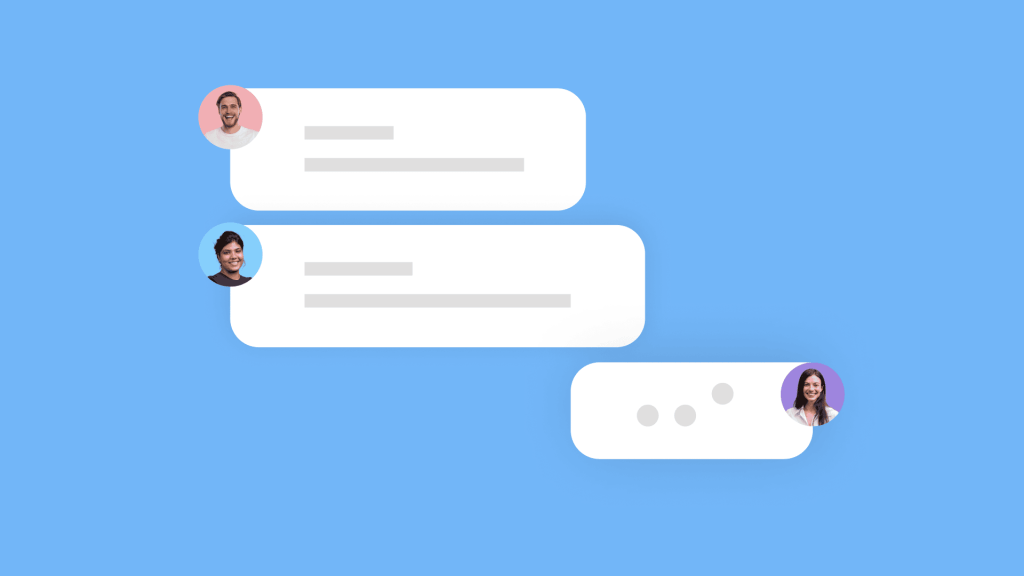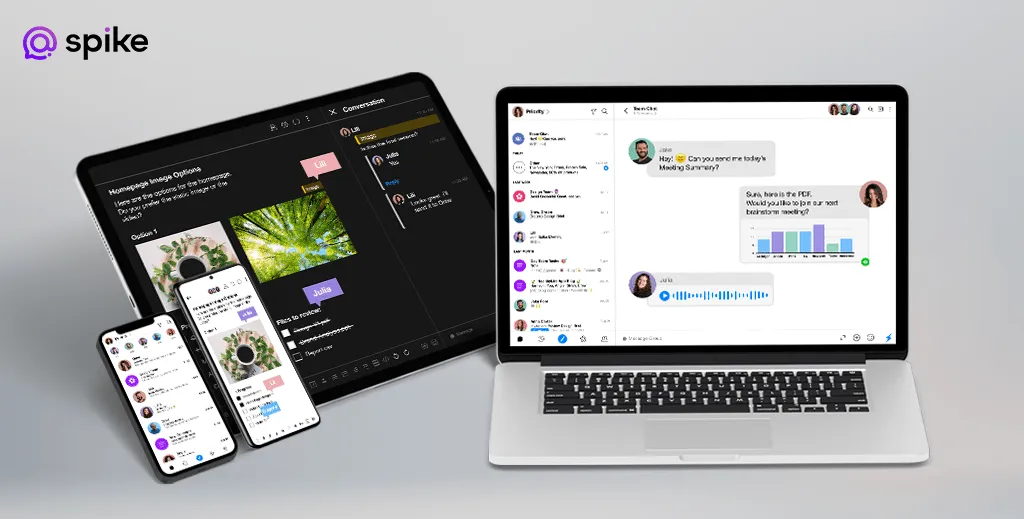Chat Etiquette Essentials for Teams

You may think that using instant messager and chat tools at work is the ultimate path to productivity. They can be, but only if your team follows the right chat etiquette. As great as these tools are, if they are used improperly, they’ll actually reduce productivity. Chatting about the work can’t become more important than actually doing the work. And that’s just one of the many mistakes that can happen when you don’t follow proper chat etiquette. Keep reading to learn the essential aspects of chat that you need to know.
Don’t Talk too Much
The most common mistake we see in team chats is people talking too much instead of getting actual work done. It can be hard to know when to stop talking, but here are some tips:
-
•
If someone asks you a question, answer it and let them do their work. If they need more information, they will ask again (or send you a message).
-
•
Never share your thoughts/opinions on something that has already been discussed or decided upon. If it’s not relevant anymore, then there’s no reason for everyone else in the chat to be reminded of it every time someone mentions it! Let sleeping dogs lie—and don’t wake them up unless there’s a good reason for doing so (like asking if anyone would like an extra coffee).
Think Before you Send
It may seem like common sense for team chat etiquette, but take a moment to consider your recipient. Does the person you’re messaging have time to respond? Is this an appropriate topic for them at that moment? Are they in a good mood or feeling overwhelmed with work? If the recipient is not receptive to the message, then it’s probably best not to send it.
Think about the context of your team chat before sending a message. You want your conversations with teammates and clients to be productive and move projects forward – not be derailed by a joke that goes too far.
Ask yourself: “Do I need my teammate’s input on this?” If so, write out what you plan on saying first so there are no surprises for them when they read what’s been sent over text instead of spoken conversation.
Use the Right Tools for the Task

One of the most important things to know about chat etiquette for teams is that you should use the right tools for the job. Let’s say you’re having a discussion with your team about whether they need to update their company’s website content. You could jump on a video call, but then everyone has to stop what they’re doing to launch another app and stop what they’re working on. You could also send an email to the group, but will that conversation get derailed?
There’s no magic answer here, but as you grow your team, its vital to look at the tools your team relies on. Take Spike for example. Instead of needing an email app, a separate video chat tool, a team chat service, and a collaboration tool – you get everything in one. It’s a complete workspace for your entire team. Many times, the thought process is you need one more tool to fix everything. We think the solution is to get rid of tools when possible, so you spend less time switching apps.
Reread Before you Send

You should be thinking about the following with team chat etiquette:
-
•
Typos, spelling, grammar
-
•
Tone and meaning
-
•
Clarity and flow
-
•
Length and brevity
-
•
Required attachments and necessary links
-
•
The right people to include (use CC and BCC when appropriate)
It goes without saying, write once, and read twice, especially if you’re dealing with upper management. You don’t want to make silly mistakes just because you were in a hurry. There are a lot of reasons why you need to be more careful with your writing. You might think that it’s not a big deal, but if you’re dealing with important documents and messages that can impact your career and future, then it’s definitely worth taking the time to proofread before sending.
Group Chat Etiquette
Group chats are a great way to keep multiple people in the loop at once, but they’re not without their pitfalls. If you find yourself in an overly-chatty group chat at work, try these tips:
-
•
Start with one message at a time
When you have an idea that needs input from others, post your initial thoughts in the group chat and ask for additions or edits before sending it along. This will save everyone time and won’t overcrowd your thread with long messages that aren’t necessary for everyone involved.
-
•
Keep it short!
One of the benefits of group chats is their ease of use—but this can make them more prone to lengthy messages than smaller groups might be willing or able to take in all at once (especially if they’re full of busy people). To avoid this problem, limit yourself to one thought per message and wrap up as soon as possible; otherwise, it’s easy for things like jokes or other casual additions (like “lol”) to start piling up without adding any useful information or context.
Why Notifications are bad for Productivity, Don’t @ People Unnecessarily
If you’re a self-appointed notification policeman and think the only good notification is an ignored one, we’re sorry to break it to you: your team probably isn’t going to get more work done if everyone thinks they need to run around like chickens with their heads cut off every time there’s a new tweet or email.
-
•
Don't use @ mentions in notifications unnecessarily
Using @ people in a notification is almost never necessary or appropriate—use company-wide channels for urgent information, and personal ones for non-urgent information.
-
•
Don't use notifications as an alternative way of communicating with colleagues who prefer private messages
Because private messages send conversations directly between users instead of broadcasting them publicly in streams like usual channels do, they’re much more private than channel chats and should be used when appropriate.
-
•
Consider the time zones of your team when using @ notification
If it’s after hours for them, consider scheduling the message for a time that’s more appropriate for their work schedule.
Don’t Create Groups and Channels Without Proper Planning
Make sure you have a clear purpose for the group or channel. It can be easy to get swept up in the excitement of starting a new project or trying something different from usual, but if you don’t know what your goals are when creating the channel/group in the first place, then chances are that it won’t end well (and you’ll spend all your time trying to figure out why).
Additionally, Make sure you have the right people in the group/channel. If you want your team’s chat to actually serve its intended purpose (aka not just as another place for people to put their silly GIFs), then make sure everyone who needs access has access. That includes managers and remote workers whose input may be valuable without being physically present at HQ every day. It also means ensuring no one gets left out because they’re new or because they’ve been nudged out of other conversations by more established teammates.
Keep content in open groups so everyone is in the loop
From a transparency perspective, the use of group chat/team channels is ideal for working with nonsensitive information. It allows everyone to passively stay in the loop without having to ask multiple people for updates. Instead of four people sending a direct message with your updates for the work – each person can put them in a single team chat so everyone is in the loop immediately.
Use emojis and GIFs when appropriate
https://giphy.com/embed/xT5LMKqlcoLeHC10xa
You’ve probably heard that emojis are the new punctuation. And it’s true: They’re an easier and more expressive way to convey emotion than words alone, but don’t go over the top with them. Keep in mind that an emoji’s meaning can change depending on where you use it and how many you include at once.
Also, remember that some symbols aren’t universally understood! A smiley face may mean one thing to someone from New York City and something else entirely to someone from Paris or Tokyo—so try not to assume too much about anyone else’s cultural background or expectations when using emojis in chat conversations with coworkers around the world.
When using GIFs – don’t overuse them. You’ll also want to consider the source of the GIF, how it could be perceived, etc. When in doubt – pick another one.
Keep Messages Concise
A quick tip: Keep your messages to the point, and use bullet points to break up your message. If you can say it in two sentences, there’s no reason to use ten.
-
•
Don’t use too many emoticons or emojis.
-
•
Don’t over-exclamation-point a sentence! It can come across as rude and unprofessional.
-
•
Don’t use too much jargon—even if it’s industry-specific jargon, you need to make sure that everyone on the team understands what you’re saying.
Search Before you Ask a new Question
When you have a question for someone, take the time to search your team chat history before asking it. There’s no reason to ping them unnecessarily just because you don’t want to take the time to look for the answer.
As the old saying goes: a lack of preparation on your part isn’t an emergency on my part. Searching for answers on your own is a key team chat etiquette reminder, and a key example when looking for asynchronous communication examples.
Acknowledge Receipt of a Question Even if you Don’t Have the Answer Right Away
You don’t have to be a superhero with an encyclopedic memory of the company directory, but you should at least acknowledge receipt of every question you receive. A simple “Got it, will check” or “I’ll get back to you later” is enough to let your teammate know that they were heard and understood—and that helps them feel comfortable to approach you with any follow-up questions. A general rule is to get back to someone with the information within 24 hours during the week.
Don’t Just say “hey”, Explain why You’re Messaging

Let’s face it, there are literally thousands of reasons why a team member might contact you during the day. But without context and explanation, your teammates won’t know what to do with your message. And if they don’t understand what you need or want, they may not respond until they have time to ask questions (which could take a while). This means that everyone loses out on valuable time and productivity.
So when you send someone a message, explain why you’re messaging them. Instead of: “Hey Bobby, let me know when you’re available, I have a question for you.”, include context and send something like: “Hey Bobby! Good morning! Can you let me know about the status of the website copy when you have a moment?”
Team Chat Etiquette Wrap Up
Team chat tools are a fantastic way to increase productivity – if they are used properly. Our guide includes our tried and true methods for turning team chat into a productivity powerhouse rather than a drain on your time and attention. Start implementing them today, and you’ll be shocked at how useful they are to your workflows and how they can motivate remote employees to get more work done with less effort.




